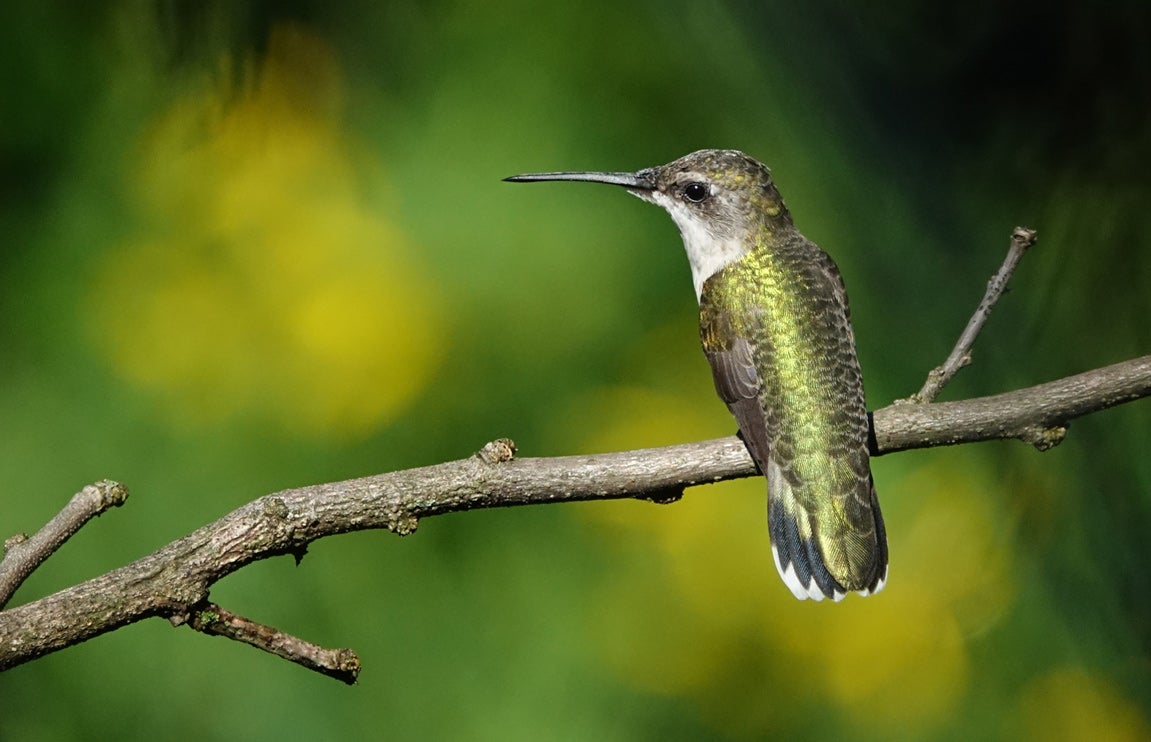Hummingbird Nectar Recipe
Learn how to make hummingbird nectar (and some great fun hummingbird facts!) from Smithsonian bird ecologist Brian Evans and nutritionist Erin Kendrick.
Ingredients
- Refined white sugar
- Water
Directions for making safe hummingbird food:
- Mix 1 part sugar with 4 parts water (for example, 1 cup of sugar with 4 cups of water) until the sugar is dissolved
- Do not add red dye
- Fill your hummingbird feeders with the sugar water and place outside
- Extra sugar water can be stored in a refrigerator
- Change feeders every other day and thoroughly clean them each time to prevent harmful mold growth
Since 1970, bird populations in the U.S. and Canada have declined by 29%, or almost 3 billion birds. Learn how you can help migratory birds and support the Smithsonian's National Zoo as we save species.
Frequently Asked Questions
Yes! You can use tap water to make your hummingbird nectar.
Always use refined white sugar (regular table sugar). Never use honey, corn syrup or raw, unprocessed sugars.
Powdered sugar (also called confectioners' sugar) often contains additional ingredients, such as cornstarch. Therefore, it is not recommended for use in creating hummingbird food.
No, the water for your nectar does not need to be boiled. Just be sure to stir or shake your mixture until the sugar is fully dissolved in the water.
A part can be any type of measurement (e.g., cup, ounce, quart, etc.) but will always be equal. To calculate 1 part sugar and 4 parts water for your recipe, first choose a measurement for “one part.” Then, do some simple math:
1 x (chosen “one part” measurement) = total sugar
4 x (chosen “one part” measurement) = total water
For example, if you want to make a large batch of sugar water, you might decide that for your recipe 1 part = 2 cups.
1 x 2 cups = 2 cups sugar
4 x 2 cups = 8 cups water
So, in this example, you would mix 2 cups of sugar (1 part) with 8 cups of water (4 parts).
To make a smaller batch of sugar water, you might decide that for your recipe 1 part = ½ cup.
1 x ½ cup = ½ cup sugar
4 x ½ cup = 2 cups water
So, in this example, you would mix ½ cup of sugar (1 part) with 2 cups of water (4 parts).
Extra sugar water for your hummingbird feeder can be stored in the fridge but should be stored for no more than one week. If you observe any mold growing on your sugar water stored in the fridge, throw it away and make a new batch for your hummingbird feeder.
It’s recommended that feeders be changed and thoroughly cleaned every other day, but it is important that they are cleaned and refilled at least twice a week in hot weather (summer) and once a week in cooler weather (spring/fall) to prevent the growth of mold.
Hummingbirds are migratory, so the timing of when you should set up or take down your hummingbird feeder depends on where you live. Here are some approximate guidelines:
- Along the Gulf Coast and other southern parts of the U.S., feeders can be set up from mid-February to early November.
- In the middle latitudes, they can be placed from early-to-mid April through late October.
- Farther north, they can be set up from early May to late September.
Keeping clean feeders up longer than these guidelines suggest does no harm and can help any stragglers. If you live in an area where hummingbirds occur all year, there's no need to take feeders down. It’s a myth that leaving hummingbird feeders up too late in the fall will prevent the birds from migrating. Hummingbirds have an internal clock regulated by the changing day length, which lets them know when it’s time to go.
Place your feeder in the shade away from windows and areas with a lot of activity. If possible, place your feeder near trees. Hummingbirds are territorial and like to perch in nearby trees to chase away intruders at their feeding area.
Red dye or coloring isn’t necessary to attract hummingbirds and could be harmful to the birds.
Hummingbirds like flowers that produce a lot of nectar, such as bee balm, salvias, weigela, trumpet honeysuckle (and other trumpet vines) and bleeding hearts. Red, tubular flowers are especially popular with these birds.
Many nursery flowers are bred for color, longevity and size but don’t produce much nectar, but some nurseries may have sections devoted to hummingbirds. Learn more about flowers that attract hummingbirds here.
You can find more ways to help hummingbirds (and all pollinators) on the Bird Friendly Home and Yard page.
Did you know the Smithsonian's National Zoo and Conservation Biology Institute is working hard to save birds all over the world? Every little bit helps! Consider making a donation today.
